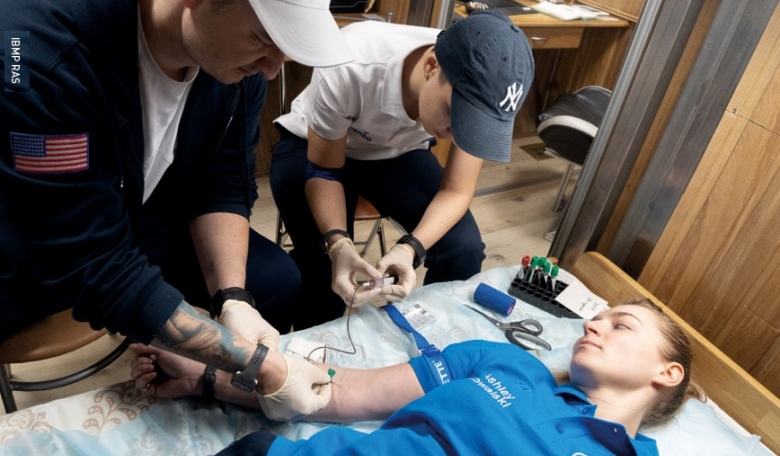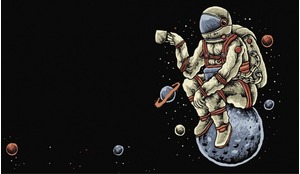Human deep space exploration requires solving a number of complex problems in various fields of science and technology, including medical support. Human spaceflight is associated with the restructuring of a whole range of processes in the body’s physiological systems which have been monitored and analysed for many years. However, specific changes in the female body under space conditions have not been studied in sufficient detail, because many more men than women have been involved in space missions. Nevertheless, the participation of women in space flights is increasing every year and the exploration of deep space would be unthinkable without the participation of women.
The Institute of Biomedical Problems (IBMP) in Moscow pays a lot of attention to ground-based research devoted to studying the impact of spaceflight factors on the female body, as well as the development of preventive means to maintain women’s inflight health.
Scientific projects that provide the opportunity to collect and study biological material from the participants of experiments that imitate real spaceflight give researchers a unique opportunity to study shifts in the functioning of different body systems, to outline the range of risks that can be expected in space, and to develop timely preventive methods for the possible adverse effects on the body’s physiological systems. The results of such studies make it possible to develop recommendations for the biomedical support of women during space flights.
The most recent spaceflight simulation (SIRIUS-21) concluded in the summer of 2022. During the eight month project , IBMP scientists, supported by Asgardia the Space Nation, studied changes in a range of factors in female volunteers in long-term isolation in a pressurised facility: microbiological, immunological and bone status; body composition; mineral and bone exchange and electrolyte and hormone concentration dynamics.
 Studyng the physiological parameters of the sleep-wake cycle - Ashley Kowalsky (left) and Victoria Kirichenko.
Studyng the physiological parameters of the sleep-wake cycle - Ashley Kowalsky (left) and Victoria Kirichenko.
Immune system changes
The results of such studies make it possible to develop recomm- endations for the biomedical support of women during spaceflight
It is extremely important to study changes in the female immune system during spaceflight, because when the immune system is out of balance, a variety of pathological phenomena can appear. These may include infectious diseases and cancer, on the one hand, and allergic and autoimmune conditions with excessive, inadequate and uncontrolled immune response on the other.
Cells and humoral factors of the immune system are distributed in almost all organs and tissues of the body in a special way, participating in the operation of many physiological systems and affecting vital functions of the body.
One of the most important evaluation parameters is that of the B-cell link of immunity, which provides a point-specific humoral immune response against a certain antigen. It turns out that during the period of adaptation to the isolation conditions, some of the immune system parameters show changes characteristic of the stress state and adaptation shift in the immune system. One investigation showed that, in the post-landing recovery period (after a relatively short period of time - seven days), the values of all the analysed parameters increased and did not differ practically from the background values, indicating a fairly rapid and complete replenishment of the B-cell functions after landing.
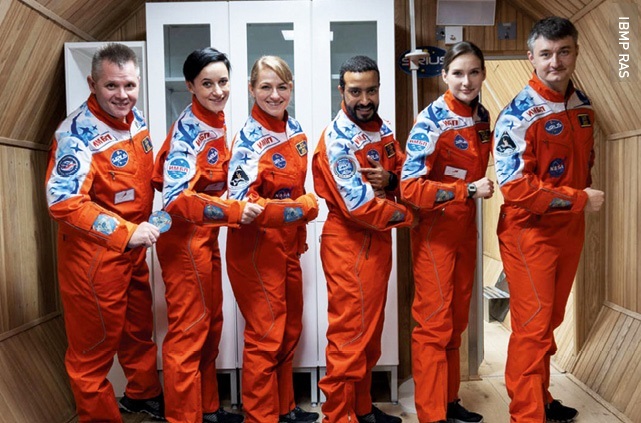 SIRIUS-21 eight-month isolation crew inside the facility. Pictured (from left): Oleg Blinov, Victoria Kirichenko, Ashley Kowalski, Saleh Omar Al Ameri, Ekaterina Koryakina and William Brown.
SIRIUS-21 eight-month isolation crew inside the facility. Pictured (from left): Oleg Blinov, Victoria Kirichenko, Ashley Kowalski, Saleh Omar Al Ameri, Ekaterina Koryakina and William Brown.
Changes in the bone system
One of the important aspects of preserving the performance and quality of life of cosmonauts in spaceflight is the development of a system of comprehensive preventive interventions aimed at reducing the risk of developing disorders of bone mineral density, its structure and strength.
Currently, on the threshold of long-distance and long-term spaceflight, studying the state of astronauts’ musculoskeletal system becomes particularly relevant. During lunar and extraterrestrial expeditions, the human musculoskeleton will have to function in new conditions, different from orbital flights, when the daily gravitational load is lower than on Earth, but the physical efforts during activities may be more significant and prolonged.
The relative rarity of female space flights means that we cannot investigate all medical aspects of the effect of space factors on their bodies, which is why experiments in mineral metabolism and morphofunctional bone disorders conducted on Earth give us an opportunity to obtain unique medical and biological data.
One of the first significant experiments involving eight women was a long-term, 120-day anti-orthostatic hypokinesia (bed rest) study conducted in the early 1990s at IBMP. The pharmacological corrections for changes in calcium metabolism and bone tissue condition that were tested in the experiment were promising.
It is extremely important to study changes in the female immune system during spaceflight because, when the immune system is out of balance, a variety of pathological phenomena can appear
X-ray gamma absorptiometry was used to investigate the reactions of the female bone skeleton to a long-term deficit of mechanical load, as well as the state of electrolyte exchange and hormonal regulation of bone metabolism at different stages of the experiment. Scientists found interesting features of mineral redistribution in the female participants, which could indicate some differences in the processes of bone tissue adaptation to simulated weightlessness in women and men.
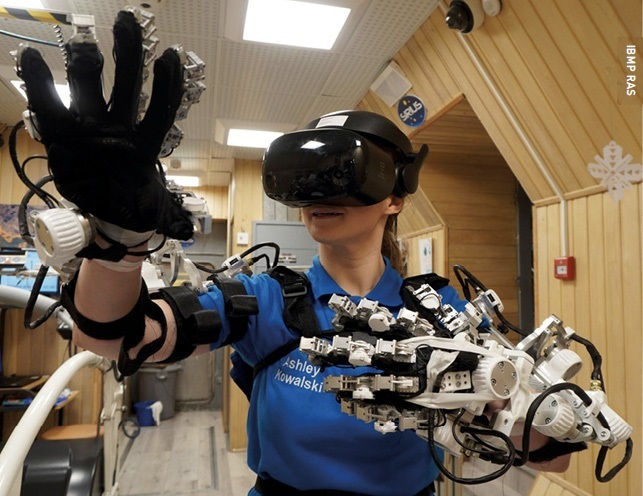 Experiment looking at the remote control of an anthropomorphic robot.
Experiment looking at the remote control of an anthropomorphic robot.
Another relevant and bone-related research objective is to assess the effect of extreme factors on the content and ratio of fat and lean mass of both the entire human body and its individual regions. It is no coincidence that the FRAX® algorithm (fracture risk assessment tool), developed by the World Health Organisation to determine the 10-year risk of bone fractures, uses a close relationship between bone mineral density and body mass index, indicating the influence of modifications in fat metabolism on bone metabolic processes.
Also of practical importance for space medicine is the assessment of nutritional status, which analyses the adequacy of energy intake from food and the complex of key nutrients during prolonged exposure of the body to spaceflight factors required to correct the nutrition of cosmonauts. These studies allow us to understand the processes of metabolic adaptation of the body to new conditions.
When a person is isolated in a hermetically closed facility, a number of spaceflight factors are simulated, such as an artificial environment without natural light and seasonal changes, chronic stress and change of habitual diet. They have significant influence on metabolism regulation in a body and affect processes of bone remodelling.
The comprehensive approach to studying the condition of the bone system that we developed included bone X-ray densitometry; blood and urine analysis of neuro-immunoendocrine regulation of physiological processes including thyroid and sex hormones; bone markers and electrolytes; and non-invasive methods of screening observation of the bone condition and body composition.
After 240 days in isolation, participants in the SIRIUS-21 experiment had an increased proportion of lean mass and decreased fat component. There were no critical changes in bone mineral content and bone density in the skeletal areas lumbar vertebrae L1-L4 and proximal femur.
Osteodensitometry of the heel bone, performed monthly, provided information on the biomechanical characteristics of the bone directly under isolation conditions and showed multidirectional changes, presumably associated with different modes of physical training in the participants. The results of the instrumental measurements and biomaterial analysis will be included in the database for further statistical studies when a sufficient number of observations is accumulated.
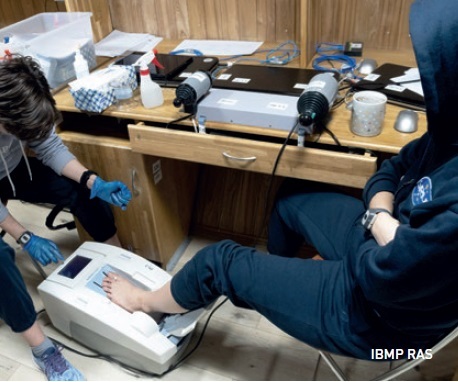 Studying the dynamics of heel bone density.
Studying the dynamics of heel bone density.
Changes in the microflora
Microflora plays an important part in the prevention of inflammatory diseases of all biotopes of the human body and creates a barrier to opportunistic microorganisms that can cause dysbiotic conditions and, in a neglected state, inflammatory processes.
Factors of a space mission, such as work in stressful conditions, altered diets and hygienic procedures, constant microbial exchange between crew members in a confined space (on a spacecraft or hypothetical lunar station) cause negative changes in the microflora of various biotopes.
In many model experiments simulating certain factors of a space flight an increase in the number of opportunistic microorganisms and a decrease in the number of protective ones in the intestinal and upper respiratory tract were observed.
However, in these earlier model experiments the test subjects were mostly males, so the effect of simulated factors of spaceflight on the vaginal microbiome has not been studied before. The microflora of this biotope play an important part, not only in creating a barrier to opportunistic microorganisms, but also affects the fertility of women, in particular the success of fertilisation.
The main component of the normal vaginal microbiota is Lactobacillus spp. Maintaining a high number of lactobacilli in the vaginal microflora is an important condition for maintaining the health of female participants of long-term space missions and is directly related to the chances of getting pregnant.
It was concluded from the eight-month isolation participants that the number of almost all anaerobic and facultative anaerobic opportunistic pathogens in the vaginal and cervical canal biomaterial increased after the experiment.
Meanwhile, the number of protective lactobacilli decreased to a lower-than-normal level. Such changes may lead to the development of inflammatory conditions and indicate the need for the development and use of preventive means.
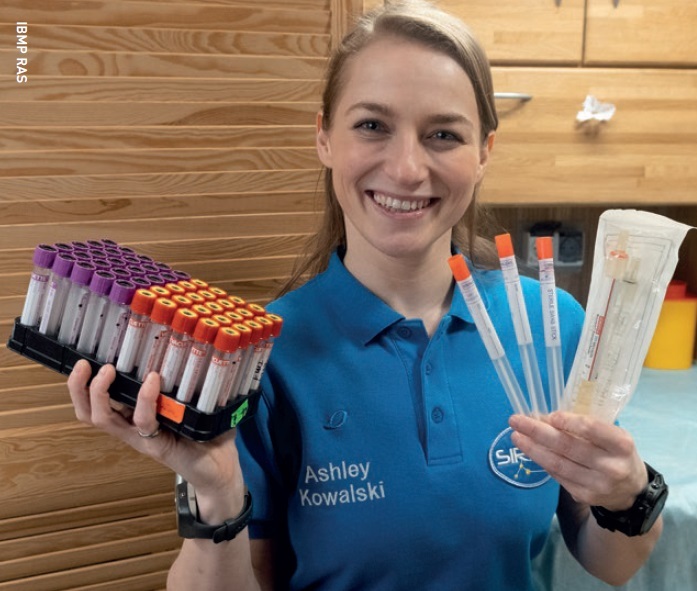 Test subject Ashley Kowalsky ready for biosampling (sampling blood and mouth swabs).
Test subject Ashley Kowalsky ready for biosampling (sampling blood and mouth swabs).
Continued studies
In conditions of long-term spaceflight, the human body faces a spectrum of adverse influences
In conditions of long-term spaceflight, the human body faces a spectrum of adverse influences affecting a number of physiological systems. Ground-based isolation experiments simulating the conditions of a long-term space flight provide invaluable factual material which helps us to understand the processes underlying the functional transformations of the body systems under the action of spaceflight factors.
During the SIRIUS-21 experiment, we obtained data on the dynamics of parameters describing changes in the microbiological, immunological and bone status, body composition, mineral and bone exchange electrolyte and hormone concentration dynamics in female volunteers staying in a long-term isolation condition in a pressurised facility.
The study revealed a complex of changes in the systems studied, apparently of an adaptive nature. However, due to the small group size, the data obtained was not sufficient and further studies are required for a deeper understanding of the processes occurring in the female body under the effects of spaceflight. Work on the study of these processes will continue.
About the authors
Anna R Kussmaul has a PhD in Biology and is a Deputy Head of Department/Senior Researcher at the Institute of Biomedical Problems of the Russian Academy of Sciences (IBMP RAS), Moscow, Russia. She is a Full member of the International Academy of Astronautics.
Galina Vassilieva has a PhD in Medicine and is a Head of Bone & Metabolic Effects of Microgravity Research Laboratory at the Institute of Biomedical Problems of the Russian Academy of Sciences (IBMP RAS) and a Head of Planning Research & Staff Procedures of the SIRIUS project. She is a Full member of the International Academy of Astronautics.
Daria Komissarova has a PhD in Biology and is a Deputy Head of the Nutrition, Gastroenterology and Hygienic Control Laboratory at the Institute of Biomedical Problems of the Russian Academy of Sciences (IBMP RAS).
Victoria Kirichenko is a surgeon (general surgery and endovascular surgery), a Junior Researcher in the Department of Operational Management of Spaceflight Medical Support at the Institute of Biomedical Problems of the Russian Academy of Sciences (IBMP RAS). She is a PhD student at IBMP RAS and the SIRIUS-21 crew physician.
Sergey Ponomarev has a PhD in Medicine and is a Head of Physiology of the Immune System Laboratory at the Institute of Biomedical Problems of the Russian Academy of Sciences (IBMP RAS). He is the SIRIUS Project Executive Director and a Corresponding member of the International Academy of Astronautics.





